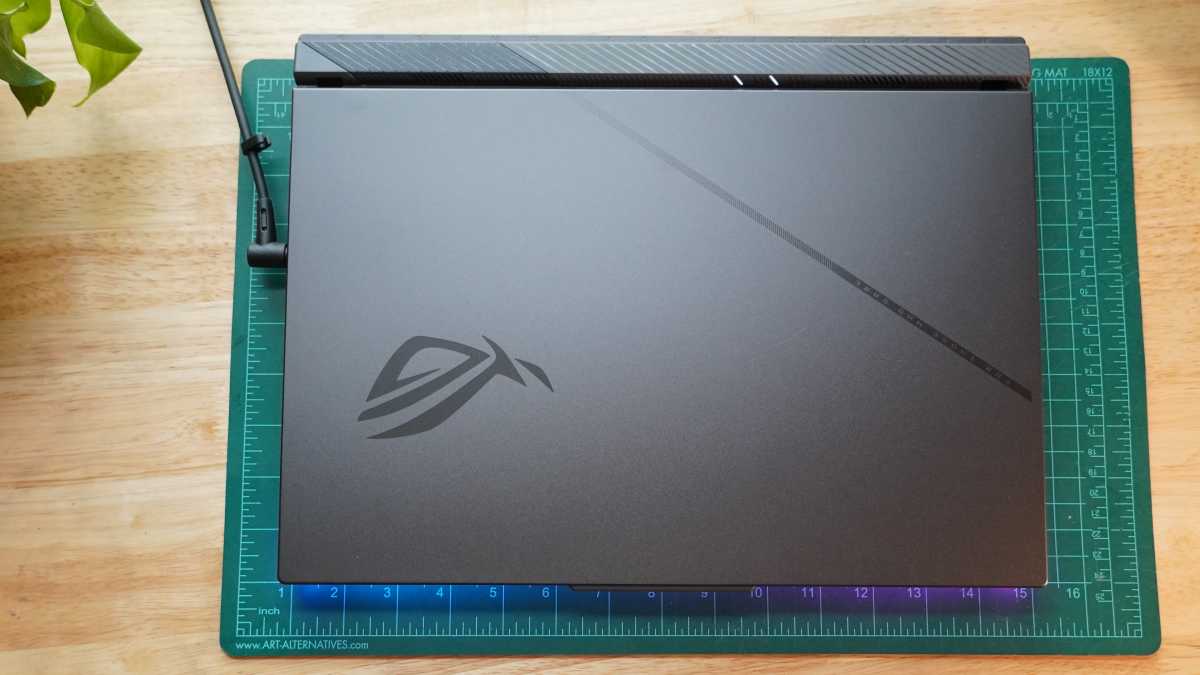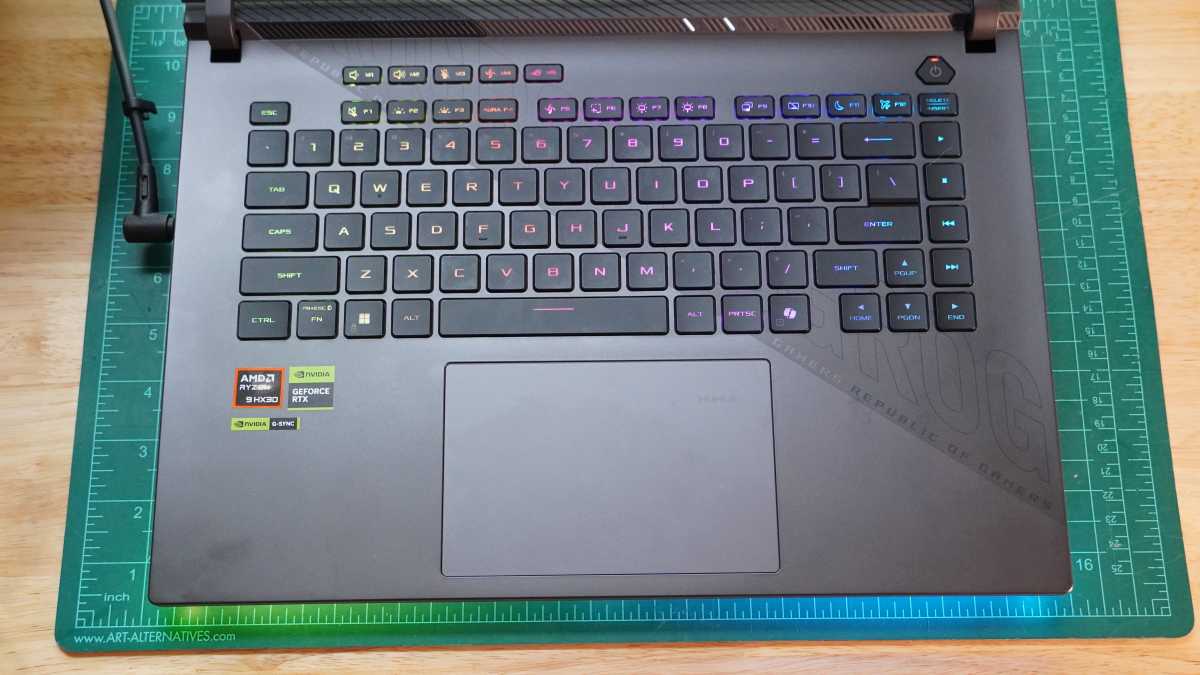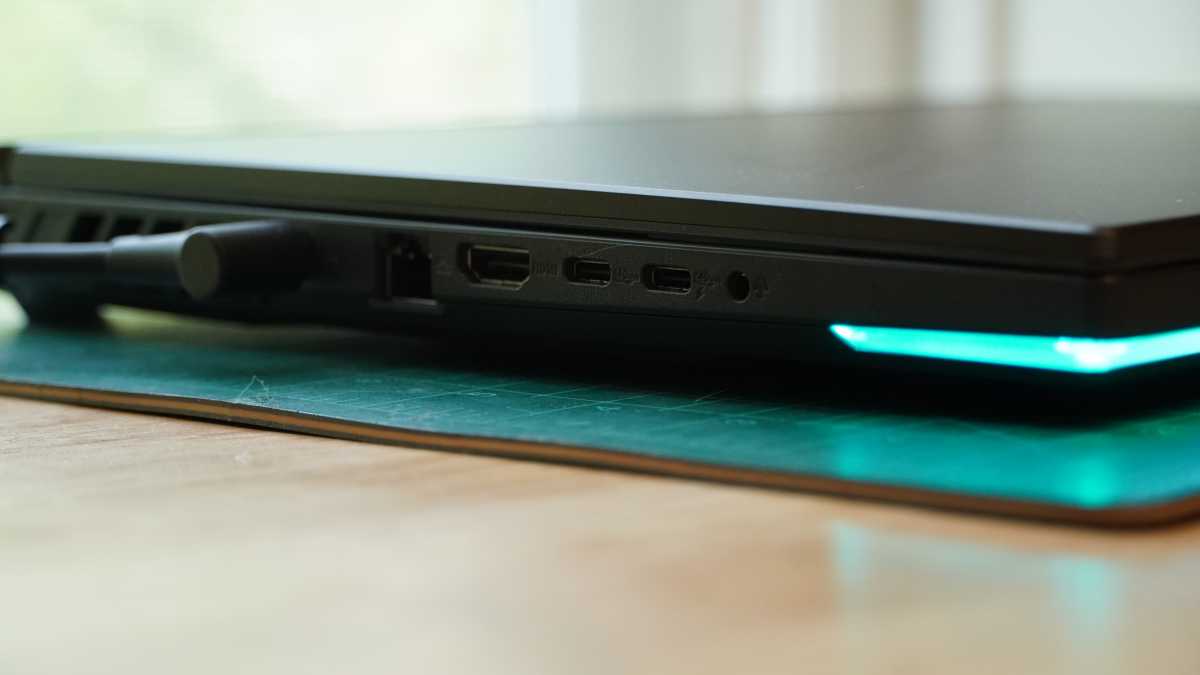Expert's Rating
Pros
- Excellent CPU performance
- Cooling readily keeps up with the internals
- Fast display
- Supports USB-C charging at 100W
Cons
- Bulky and plasticky
- Speakers are grating at full volume
- So-so battery life for gaming laptops
Our Verdict
The Asus ROG Strix G16 isn’t the ultimate gaming laptop, but it delivers exceptional performance for its hardware, rivaling last-gen RTX 4080 systems. It’s not the sleekest, but it’s well-built and more affordable than Lenovo’s class leader.
Price When Reviewed
This value will show the geolocated pricing text for product undefined
Best Pricing Today
The Asus ROG Strix G16 (G614) is a solid gaming laptop entering the mid-to-high range of the market, as it’s capped at an RTX 5070 Ti. It may not have the most elegant build, combining mostly plastics with an aluminum lid, and its IPS display isn’t quite as jaw-dropping as OLED rivals, but the Asus ROG Strix G16 puts up powerful performance for the money, proving itself a worthy rival to the Lenovo Legion Pro 7i 16 Gen 10, even if it can’t quite dethrone that beast. With a starting price of $1,599 and options up to $2,499, there’s a good bit of room to configure a system that suits your needs without going overboard. But as tested here at the height of the range, it’s one heck of a performer.
Asus ROG Strix G16: Specs and features
- Model number: G614
- CPU: AMD Ryzen 9 9955HX3D
- Memory: 32GB DDR5-5600
- Graphics/GPU: Nvidia RTX 5070 Ti 12GB VRAM, (140-Watt TGP)
- Display: 16-inch, 2560×1600 IPS, 240Hz, 500 nits, 100 percent DCI-P3, G-Sync, Dolby Vision HDR
- Storage: 1TB PCIe Gen4 SSD
- Webcam: 1080p + IR
- Connectivity: 2x USB4 (1x 100W PD support), 2x USB-A 10Gbps, 1x HDMI 2.1 FRL, 1x GbE, 1x 3.5mm combo audio
- Networking: WiFi 6E 2×2, Bluetooth 5.4
- Biometrics: Windows Hello facial recognition
- Battery capacity: 90 watt-hours
- Dimensions: 13.94 x 10.39 x 1.2 inches
- Weight: 5.22 pounds
- MSRP: $2,499 as-tested ($1,599 base)
The Asus ROG Strix G16 comes in several configurations. A few come from Asus directly while some are exclusive to Walmart and Best Buy and have different displays from Asus’s direct offerings. All of them are built around AMD CPUs and RTX 50-series GPUs. Support for Wi-Fi 6E, dual SSD slots, 1TB of included PCIe Gen 4 storage, 90Wh batteries, and 280W chargers are all common among them.
The base model is a Walmart-exclusive, starts at $1,599, and includes an AMD Ryzen 9 9955HX CPU with 16GB of memory, and an RTX 5060 GPU. The display here is a 1200p IPS panel with a 165Hz refresh rate, 300 nits of brightness, and 100 percent sRGB color gamut. Best Buy has two more models using the same display. These both come with an earlier AMD Ryzen 9 8940HX CPU. A $1,699 model includes an RTX 5070 and a $1,999 model bumps to an RTX 5070 Ti.
The rest of the configurations come directly from Asus and bump up to a 1600p, 240Hz panel with a 500-nit brightness level, G-Sync, 100 percent DCI-P3 coverage, and Dolby Vision support. They also get 32GB of memory. The first of these models is $2,199 and includes an RTX 5070. For $2,399, the GPU gets a further upgrade to an RTX 5070 Ti, but all else remains the same. Finally, at $2,499, we reach the configuration tested here. This bumps up CPU, swapping to an AMD Ryzen 9 9955HX3D.
These varied configuration and retailer options provide an interesting mix that should allow gamers to select their priorities. Walmart offers the cheapest entry point, while Best Buy’s options favor value on the GPU side, letting you land an RTX 5070 Ti for $400 less than Asus’s configuration. Meanwhile Asus’s configurations offer a higher-grade display for those who plan to do a lot of gaming directly on the laptop.
The ROG Strix G16 doesn’t just game—it competes, balances, and delivers where it counts. It’s not trying to win a beauty pageant; it’s here to dominate the leaderboard.
Asus ROG Strix G16: Design and build quality

IDG / Mark Knapp
The Asus ROG Strix G16 isn’t subtle about being a gaming laptop. From its textured and striped exhaust tail, the large grilles on both the sides and back, various branding on just about every surface, a completely over-engineered base plate (done up to look a bit like a motherboard with a CPU socket), and all the RGB lighting, it just about shouts “gamer.” The RGB even extends a bit beyond the typical keyboard backlight. A lightstrip stretches across the front edge of the laptop to cast a colorful glow in front of the Asus ROG Strix G16.
The system is bulky, measuring over an inch thick, but it’s almost surprisingly light for its size. It weighs 5.22 pounds, which still isn’t light but is kind of light for a 16-inch gaming laptop. A lot of that weight and size is coming from the cooling system. The Asus ROG Strix G16 has ventilation wrapping around the back half of the base, completely spanning the rear and covering a portion of each side. There are even two little vents on a little hinge shelf above the keyboard. Asus uses a triple-fan arrangement to cool the internals, though one of these is quite small. With such wide ventilation, the system doesn’t have to go shrill during heavy gaming. It produces a light breeze sound that’s not unpleasant to hear even at an arm’s length
With all that’s packed in, the Asus ROG Strix G16 ends up sturdy, with little flex to the base even though it’s all made out of ABS and polycarbonate. Only the display lid gets a touch of the premium with an aluminum cover. The ABS plastic on the bottom of the system feels rough and a little cheap, but still tough. There’s just enough flex from the display that it bends a little when opening or closing it with a hand on the corner, but a little lip at the top provides a more balanced point for opening and closing.
The Asus ROG Strix G16 comes with a beefy 280-watt power brick for charging, and it adds almost another 1.5 pounds to the package. On the bright side, 100-Watt USB-C charging is also supported if you want to use a smaller charger on the go.
Asus ROG Strix G16: Keyboard, trackpad

IDG / Mark Knapp
Physically, the keyboard is a joy to type on. It has a satisfying, soft bottom out that makes for comfy typing. I was comfortably able to type at over 110 words per minute without feeling like I was rushing in Monkeytype, and managed a fair degree of accuracy.
It has a couple of downsides, though. Asus prioritized full-sized arrow keys, and it shrank the right shift key considerably in the process. I find myself regularly hitting the up arrow when I mean to hit shift, and instead of getting a capital letter, I start messing up a whole paragraph. As helpful as the RGB keyboard lighting is for seeing key legends in the dark, the slightly dark key legends when backlighting is off can make it a little hard to see the keyboard even in a well lit room.
Once in the course of my testing, in the middle of using it, the keyboard suddenly stopped working entirely. The trackpad still worked, but neither keys nor keyboard shortcuts worked. After plugging the system in and letting it restart, the keyboard resumed proper functioning, but it was an odd and upsetting experience nonetheless. I’ve never known a computer not to have the odd hiccup now and then, though, and as this wasn’t a recurring issue, I didn’t raise too much concern.
For gaming, the keyboard deck gets a little warm, but the palm area doesn’t, and the WASD keys are comfortable to rest on. Only the area around the number row and above heats up, as that’s where most of the heatsink sits.
The Asus ROG Strix G16’s trackpad is reasonably spacious, pleasingly smooth, and offers a satisfying, soft physical click. t could be wider, but after experiencing frequent palm rejection issues on the Razer Blade 16’s ultra-wide trackpad, I’m not mad at Asus for keeping it modest.
The trackpad has a special function seen on a number of other Asus laptops. With a long-press near one corner, it can turn into a number pad with illuminated characters and math function keys. It’s an interesting feature to have, but the beauty of a number pad is how muscle memory allows for touch typing, and this setup doesn’t really facilitate that quite as well.
Asus ROG Strix G16: Display, audio

IDG / Mark Knapp
The Asus ROG Strix G16’s display is good overall. It has a lot going for it. For one, it delivered 480 nits of brightness in my testing, and that combines with a strong anti-glare coating that makes it easy to see in almost any conditions. The 2560×1600 resolution is respectably sharp, and it runs at a super-smooth 240Hz with only minor ghosting. It’s also wonderfully colorful, fully covering the DCI-P3 color space. Color accuracy wasn’t on point, though. The display also exhibits some annoying dimming behavior, slowing ramping the brightness up or down depending on the screen content. It doesn’t show up much while gaming or watching movies, but while browsing the web, where the brightness of content can change suddenly, it becomes distracting.
The two down-firing speakers provide respectable, clear audio for voices, making for a good way to listen to instructional/educational videos or have voice calls. They pump out plenty of volume, but it’s a bit harsh at max volume. Dialed back, the speakers still provide ample volume and decent fullness without the same harshness. There’s even a bit of bass. Asus suggests they’re capable of Dolby Atmos audio and can play into virtual 5.1.2-channel surround sound, but that is extremely generous for speakers that barely manage basic stereo.
Asus ROG Strix G16: Webcam, microphone, biometrics
The webcam on the Asus ROG Strix G16 is decent. It can get a little grainy in dimmer environments, but it does an impressive job with exposure. It manages to get most of the picture clear without overexposing. It’s not a master though, in extra-dim rooms with one strong light, it can run into overexposure in its effort to get the rest of the picture lit up, but even then it looks acceptable.
The microphones are solid. They pick up my voice loud and clear without too much room echo. They also do a good job cutting down on background noise. Even with a box fan running in a window nearby and construction outside, my voice remained clear without awkward compression or clipped words, and the fan itself was inaudible while the construction was reduced to subtle clinking.
Unfortunately, you’ll be relying on a password, PIN, or security key to log onto the Asus ROG Strix G16. It doesn’t feature any facial or fingerprint recognition technology.
Asus ROG Strix G16: Connectivity

IDG / Mark Knapp
Like most big gaming laptops, the Asus ROG Strix G16 provides a good smattering of ports. You’ll find two USB4 Type-C ports on the left side, and one of those supports 100W power delivery for charging without the G16’s beefy power brick (though don’t expect full performance while plugged in this way). There’s also a 3.5mm headset jack, HDMI 2.1 port, and Gigabit Ethernet port over there along with the main DC barrel jack. The right side of the laptop includes two USB-A 10Gbps ports. An extra USB-A port or SD/microSD card slot would have been nice to see. Unfortunately, Asus’s cooling design takes up the entire rear of the laptops and half of each side, so all of the ports are lined up along the front half of either side. I find this awkward when plugging in multiple devices, especially if you plan to game that way, as you’ll have USB dongles/cables sticking out right where you’d likely want a mouse.
Wireless connections have been dependable. The system sup
Jelentkezéshez jelentkezzen be
EGYÉB POSTS Ebben a csoportban

If you’re already fed up with the amount of ads you see on the Amazon

If you have an older PC and are considering a memory upgrade, you mig

OLED monitors are all the rage for desktop PCs, and you can find them

Roku streaming sticks are known for their easy of use; just plug the

The M3 iPad Air is easily one of our favorite tablets, and it’s going

If you’ve been thinking about grabbing a new laptop, this one’s defin

Google is reshuffling its AI service brands, no longer to use the ter
